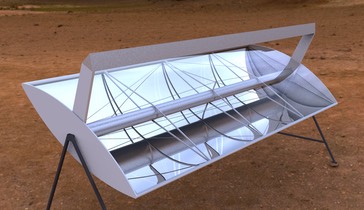Often the cost of renewables is measured on the name-plate rating, but this can be misleading. A better method is the LCOE. For example, a solar PV panel rated at 100 watts and having a capacity factor of 17% will produce:
100 Watts X 24 hours X 365 day X 17% = 148,920 watt hours or 148 kWh per year.
If this same panel costs $100, then it produces power at a cost of $0.68/kWh in a year.
Now compare this to a 100 Watt CSP plant with storage and capacity factor of 80% and assume this plant will cost more - $300 for example.
On the surface it appears the PV panel is the cheaper option, but when we take into account the higher capacity factor of 80%, lets see what happens.
100 Watts X 24 hours X 365 days X 80% = 700,800 watt hours or 701 kWh per year.
If this same CSP plant costs $300, then it produces power at cost of $0.43/kWr.
This is a simplified example for illustration purposes. Actual LCOE calculations take into account longer time frames and many other factors.
The National Renewable Energy Laboratory (NREL) of the US Department of Energy (DOE) has created a program called the System Advisor Model (SAM). This sophisticated software program is able to calculate the LCOE of solar power plants based on traditional CSP technology as well as PV technology. This model only assumes an extra several hours of night time storage with a capacity factor (CF) of 40%. We plugged our numbers into the model and modified it to accommodate overnight storage with a capacity factor of 80%.
- NREL’s SAM calculates an LCOE of 13 cents per kWh for traditional CSP Trough Plants with a 40% capacity factor.
- Ultra Lite with a 40% capacity factor calculates to 6.44 cents per kWh.
- Ultra Lite with a 80% capacity factor calculates to $5.27 cents per kWh.
Interestingly enough, the LCOE with an 80% CF for the Ultra Lite plant is much less than for a 40% CF plant. The reason for this is because the solar field cost, which was traditionally the highest cost of a CSP plant, has now become a minor cost in comparison with the balance-of-plant equipment inclusive of the turbine and associated systems. Even though the Ultra Lite plant with a 80% CF has a higher capital cost due to the much larger solar field, it allows the turbine to be more fully utilized, resulting in a lowered LCOE.
Again with these being base-load power plants, the real saving are even higher without the need for traditional backup power plants.
When combining this technology with Dish or Solar Tower technology, the LCOE could potentially drop to 3.5 cents per kWh.
Global Deployment
The Levelized Cost of Electricity (LCOE) takes into account the sunshine hours in different regions of the world and is referred to as Solar Insolation. The American Southwest could have twice as much Solar Insolation compared to the Northeast. The best economics are realized in areas of the world where better solar conditions prevail.
